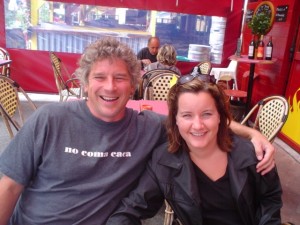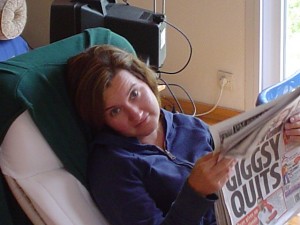In 2007, Amy and I spent a few weeks in France, and being the food safety nerd, I was struck by the indifference many of the people I met showed to foodborne illness.
 It seemed to be a point-of-pride amongst the locals to not report foodborne illness.
It seemed to be a point-of-pride amongst the locals to not report foodborne illness.
I’m familiar with the French desire for food to be alive, sexy, and part of a life well-lived, but also saw a lot of people going to McDonald’s.
We stayed for a week at a friend’s cottage in a small town in the south, and we would visit the butcher, who cross-contaminated everything.
We had dinner at a neighbor’s place one night and he confessed, that butcher, “he made me so sick with his chicken.”
And when I got home, someone told me my don’t eat poop story made it onto Letterman, while Amy developed the look.
Researchers report that community incidence estimates are necessary to assess the burden and impact of infections on health and to set priorities for surveillance, research, prevention, and control strategies.
 The current study was performed to estimate the community incidence of campylobacteriosis and nontyphoidal salmonellosis in France from the number of laboratory-confirmed cases reported to the national reference center (NRC). The probabilities of a case in the community visiting a doctor, having a stool sample requested, having a positive laboratory test, and having the case reported to the NRC were estimated using data of national surveillance systems, national hospitalization and health insurance databases, and specific surveys informing about these parameters. Credible intervals (CrI) were calculated using Monte Carlo simulation. In addition, we estimated the number of hospitalizations for both infections in France.
The current study was performed to estimate the community incidence of campylobacteriosis and nontyphoidal salmonellosis in France from the number of laboratory-confirmed cases reported to the national reference center (NRC). The probabilities of a case in the community visiting a doctor, having a stool sample requested, having a positive laboratory test, and having the case reported to the NRC were estimated using data of national surveillance systems, national hospitalization and health insurance databases, and specific surveys informing about these parameters. Credible intervals (CrI) were calculated using Monte Carlo simulation. In addition, we estimated the number of hospitalizations for both infections in France.
The annual community incidence rate in France is estimated at 842 cases per 100,000 (90%CrI 525–1690) for campylobacteriosis and 307 cases per 100,000 (90%CrI 173–611) for salmonellosis. The annual number of hospitalizations is estimated at 5182 for campylobacteriosis and 4305 for salmonellosis. The multiplication factors between cases ascertained by the surveillance system and cases in the community were 115 for campylobacteriosis and 20 for salmonellosis.
 They are consistent with estimates reported in other countries, indicating a high community incidence of campylobacteriosis and salmonellosis in France.
They are consistent with estimates reported in other countries, indicating a high community incidence of campylobacteriosis and salmonellosis in France.
Community incidence of campylobacteriosis and nontyphoidal salmonellosis, France, 2008–2013
Foodborne Pathogens and Disease. 2015 ahead of print. doi:10.1089/fpd.2015.1964.
Van Cauteren Dieter, De Valk Henriette, Sommen Cecile, King Lisa A., Jourdan-Da Silva Nathalie, Weill François-Xavier, Le Hello Simon, Mégraud Francis, Vaillant Veronique, and Desenclos Jean C.
http://online.liebertpub.com/doi/abs/10.1089/fpd.2015.1964
